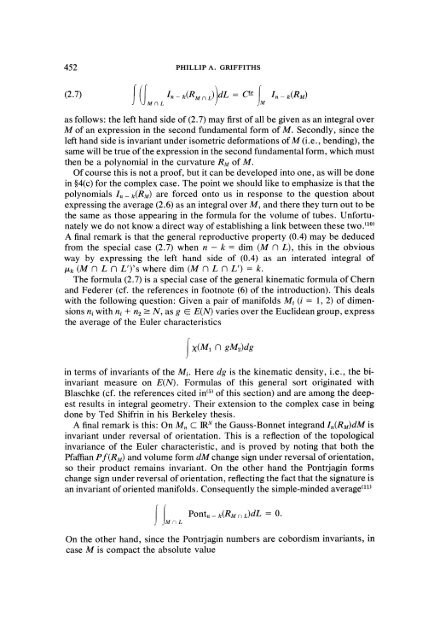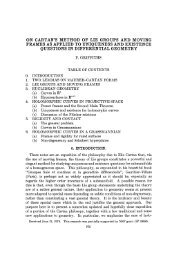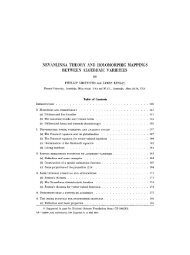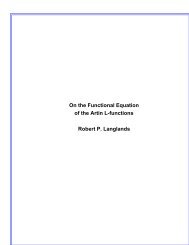View PDF - Project Euclid
View PDF - Project Euclid
View PDF - Project Euclid
You also want an ePaper? Increase the reach of your titles
YUMPU automatically turns print PDFs into web optimized ePapers that Google loves.
452 PHILLIP A. GRIFFITHS<br />
as follows: the left hand side of (2.7) may first of all be given as an integral over<br />
M of an expression in the second fundamental form of M. Secondly, since the<br />
left hand side is invariant under isometric deformations ofM (i.e., bending), the<br />
same will be true of the expression in the second fundamental form, which must<br />
then be a polynomial in the curvature RM of M.<br />
Of course this is not a proof, but it can be developed into one, as will be done<br />
in 4(c) for the complex case. The point we should like to emphasize is that the<br />
polynomials I,_ k(RM) are forced onto us in response to the question about<br />
expressing the average (2.6) as an integral over M, and there they turn out to be<br />
the same as those appearing in the formula for the volume of tubes. Unfortunately<br />
we do not know a direct way of establishing a link between these two. (1)<br />
A final remark is that the general reproductive property (0.4) may be deduced<br />
from the special case (2.7) when n k dim (M N L), this in the obvious<br />
way by expressing the left hand side of (0.4) as an interated integral of<br />
/zk (M f-I L C) L’)’s where dim (M N L C) L’) k.<br />
The formula (2.7) is a special case of the general kinematic formula of Chern<br />
and Federer (cf. the references in footnote (6) of the introduction). This deals<br />
with the following question: Given a pair of manifolds Mi (i 1, 2) of dimensions<br />
ni with n + n2 -> N, as g E(N) varies over the <strong>Euclid</strong>ean group, express<br />
the average of the Euler characteristics<br />
M1 n gM2)dg<br />
in terms of invariants of the M. Here dg is the kinematic density, i.e., the biinvariant<br />
measure on E(N). Formulas of this general sort originated with<br />
Blaschke (cf. the references cited in (5) of this section) and are among the deepest<br />
results in integral geometry. Their extension to the complex case in being<br />
done by Ted Shifrin in his Berkeley thesis.<br />
A final remark is this: On M, C IR N the Gauss-Bonnet integrand In(RI)dM is<br />
invariant under reversal of orientation. This is a reflection of the topological<br />
invariance of the Euler characteristic, and is proved by noting that both the<br />
Pfaffian Pf(R) and volume form dM change sign under reversal of orientation,<br />
so their product remains invariant. On the other hand the Pontrjagin forms<br />
change sign under reversal of orientation, reflecting the fact that the signature is<br />
an invariant of oriented manifolds. Consequently the simple-minded average 11)<br />
Pontn (RM z)dL O.<br />
On the other hand, since the Pontrjagin numbers are cobordism invariants, in<br />
case M is compact the absolute value
















